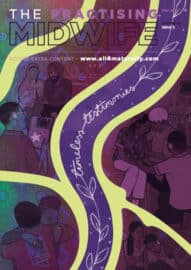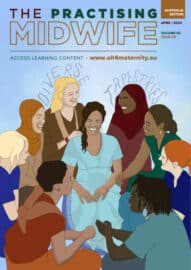Decolonising Midwifery Education Part 2: Neonatal Assessment
All authors from Leicester School of Nursing and Midwifery, De Montfort University:
Dr Diane Ménage – Senior Lecturer, Midwifery
Maxine Chapman – RM, Senior Lecturer, Midwifery, and Fair Outcomes Champion: Decolonising DMU Project
Maureen Raynor – Senior Lecturer, Midwifery
Zaheera Essat – Lecturer, Midwifery
Rachel Wells – Senior Lecturer and Programme Lead, Midwifery
Published in The Practising Midwife Volume 24 Issue 6 June 2021 https://doi.org/10.55975/NIWP1173
Summary
Assessment of the skin is an important element of neonatal examination. Therefore, midwives need to develop knowledge and skills in this area to recognise changes in the skin and understand what these signify.Historically, teaching in this area has been skewed towards changes seen in newborns with light skin tones, resulting in a gap in clinical knowledge and resources on the assessment of skin in newborns with darker skin tones. This second article, on the decolonisation of midwifery education and practice, focuses on clinical assessment of the skin when examining newborns.
*NB we have sourced images via stock websites and from the generous public, to whom we are grateful for supporting this important work of decolonising the curriculum.
Introduction

Midwives have an important role in the assessment of neonates to confirm normality, detect deviations from the norm and arrange appropriate referral. Midwives examine neonates at birth, at postnatal examinations and when performing the Newborn Infant Physical Examination (NIPE). Historically, very little attention has been paid to the significance of skin colour when teaching midwives examination skills and there is a knowledge gap around the detection of clinical signs on darker skins. There has been a lack of awareness that many skin conditions can be more difficult to recognise on darker skins, and almost all clinical textbooks use examples and illustrations of people with pale skins. Generations of clinicians have been educated in this way and it is only very recently that this gap in clinical education has been recognised and is now being addressed.1 Neonatal skin conditions are no exception to this knowledge gap. This is the second of two articles on skin assessment in maternity care, which seek to kickstart the discussion and begin to fill that knowledge gap, plus raise awareness of some of the clinical signs and features that present differently, on darker skin tones. The first article, also published in this issue, focused on enhancing knowledge and comprehension of the nuances involved in assessing women with dark skin tones, while this article discusses the nature of neonatal skin colour, assessment of the baby at birth, signs of cyanosis, skin conditions, birthmarks and neonatal jaundice. A clinical vignette and critical questions are intended to encourage readers to consider this example and reflect on their own experiences when assessing the health and wellbeing of babies with skin tones other than white.
Skin colour

Skin colour in the neonate is influenced by a number of physiological factors: the density and distribution of melanin (a dark pigment which provides protection from ultra-violet rays in sunlight); haemoglobin; bilirubin and skin thickness.2 Therefore, ethnicity, general health and gestational age will all be significant factors. Although we may think of ethnicity as the main determinant of skin colour, studies have shown that skin tone and ethnicity do not always correlate precisely.3 Skin tone varies among individuals from any given ethnic group. Therefore, it is not necessarily accurate or useful to talk about African skin or Asian skin. In fact, there is huge variety in skin colour and yet clinical textbooks on assessment of the skin are almost exclusively focused on pale skin tones. Few studies have explored this topic, although there have been recent attempts to classify neonatal skin colour.3 However, neonatal skin is relatively dynamic as babies are often born slightly paler than their parents; their skin colour developing in their first weeks or months and beyond as their skin is exposed to the natural light.3 Neonates also have areas that contain less pigment – for example, the palms of the hands – while other areas may be more pigmented – for example, the genitals, with a deeply pigmented scrotum being a common incidental finding in Black, Asian and Middle Eastern baby boys.4
General assessment of the baby at birth

Visual assessment of the skin is an important part of neonatal clinical examination and any assessment must be made in relation to individual skin tone in order to confirm normality and identify abnormalities. For the midwife, examining the baby following birth using the APGAR score provides a system for rapidly assessing newborn health using five criteria: heart rate, respiratory effort, tone, reflex and skin colour.5,6 The newborn is scored (out of two) for each criterion, usually at one minute and at five minutes, allowing a maximum score of 10. However, assessment of colour is known to be the most problematic and least reliable field, because to score two the baby needs to be ‘pink all over’. As a screening tool for detecting babies who are compromised, this description is particularly problematic. Some babies with darker skin tones may be well perfused but will not look particularly pink, making it practically impossible for them to gain maximum score in this field. This is of concern because it means that darker-skinned babies may be given inaccurate APGAR scores, which could lead to unnecessary surveillance and interventions for the baby and increased anxiety for the parents. Similarly, it may be harder to assess ‘blueness’ in the skin of a Black or Brown-skinned baby and this could lead to inadequate detection of those babies who are compromised. Therefore, there is a strong argument for reviewing and developing the APGAR scoring system to ensure that it is fit for purpose for all neonates.
Midwives have an important role in the assessment of neonates to confirm normality, detect deviations from the norm and arrange appropriate referral
Assessing for cyanosis in the neonate

Cyanosis is the blue discolouration of the skin and mucous membranes caused by deoxygenated haemoglobin.7 In neonates peripheral cyanosis is common in the first 24 hours of life and is not considered pathological if the baby is generally well.8 Central cyanosis is associated with pathology and can indicate respiratory, cardiovascular or haematological abnormalities.9 Therefore, it is essential that midwives are able to detect signs of cyanosis in neonates. As a fundamental skill in midwifery practice, teaching has been impaired by language and assumptions about skin colour. It has been the norm to talk of skin looking blue, white or ‘pinking up’ and, although this may reflect what is seen in paler-skinned neonates, it may not describe what happens in babies with darker skin tones. For this reason, we would strongly advocate moving away from this language and emphasise that the assessment of cyanosis should assess for any grey or blue discolouration of the skin (see Picture 1). It should always involve examination of the lips and mucous membrane in the mouth and tongue because these are areas where there is thin epidermis and a good blood supply in all skin colours and therefore sites that are reliable indicators of central cyanosis.1,7 Assessment of the nail beds is not useful for detecting central cyanosis in neonates under 24 hours of age, given that non-pathological, peripheral cyanosis may complicate the assessment.8 While it is essential that midwives hone their observation and examination skills for babies of all skin colours, pulse oximetry provides an important objective measurement where there are concerns. Moreover, in many maternity units this is now offered routinely as part of newborn screening.10
Neonatal skin conditions


Rashes are common in neonates and therefore midwives need to be skilled at recognising normal, harmless conditions and those that may need to be referred. Erythema Toxicum Neonatorum (commonly called Newborn Rash) can look alarming but it is an insignificant, transient rash present in approximately half of babies in the first few weeks of life – see Pictures 2 and 3.11 It can be more difficult to assess on darker skins as erythema (redness) may be less obvious.

Neonatal pustular melanosis is uncommon in white babies but is thought to affect around 5-15% of babies with Black parents.12 It resolves spontaneously but similarly it can be very concerning for parents, particularly as the small pustules develop and then turn into flat, brown lesions (See Picture 4). Careful and comprehensive inspection is key and listening to parents is important because they will often be the ones to notice subtle marks and blemishes.
Birth marks
Dermal melanocytosis (also slate grey nevus or blue spot) are blue/grey or brown patches found on newborn babies. They are a type of birth mark seen on babies of all skin tones, although they are very common in dark-skinned babies and present in up to 90% of babies from Black and Asian ethnicities.11 They are usually present from birth and found on the buttocks or lower back and they generally disappear in the first few years of life.11 See Pictures 5 and 6. Although often referred to as Mongolian blue spot, this description is an inaccurate and outdated term based on discredited race theories.13 For this reason we strongly recommend using the correct name: dermal melanocytosis or simply blue spot. Inability to accurately recognise blue spot has led to this being confused with bruising. Sadly, this has sometimes resulted in inappropriate child protection referrals, causing unnecessary distress to families.14 It is important that midwives record all birth marks and skin lesions on the body map and in all neonatal records as soon as it is noticed and continue to observe and document any changes. While remaining vigilant to the possibility of bruising from birth trauma or inflicted harm, midwives can differentiate between bruising and blue spot if they understand the distinguishing features of each.

Blue spot predominantly appears at typical sites (buttocks and back), they are patches of skin that may look blue/grey or, on dark-skinned babies, they may just look darker than the surrounding skin. They are more uniform in colour and they do not change colour.1 They are always non-tender with no associated swelling or redness. Bruises may be tender with associated inflammation. They can be blue/grey but they are less uniform in colour and the colour also changes as the bruise ages; sometimes purple and yellow tones can be seen.15 The head-to-toe examination following birth and during each neonatal examination plays a vital role in detecting bruising.
Jaundice

Ja

undice is the yellow colouration of skin and sclera caused by raised bilirubin (a bile pigment) in the circulation.16 Neonatal jaundice affects 60% of term babies and 80% of preterm babies in the first week of life.16,17 In most cases, this is a physiological jaundice that spontaneously resolves without treatment. Less commonly, jaundice is pathological and can be life-threatening. Observation and examination of newborn babies to detect those babies who may have pathogenic jaundice and require referral is an important part of neonatal care.17 Measurement using a transcutaneous bilirubinometer is recommended practice in the UK, in babies with suspected or obvious
jaundice,16,17 although it is not always available, particularly in community settings. Therefore, visual assessment is still a key aspect of assessing the degree of neonatal jaundice. This can be more difficult in babies with dark skin tones – see Pictures7-9.18 A full visual assessment should be made in good light and particular attention should be paid to inspecting the whites of the eyes (sclera), gums, palms of the hands and small areas of skin temporarily ‘blanched’ by light digital pressure.17,19
Again, listening to the parents is also key. They may notice changes in skin colour that are not evident to a midwife who has not seen the baby before or who lacks knowledge and experience in assessing babies with darker skins. In the vignette below, a midwife reflects on a neonatal examination of a baby with white and Afro-Caribbean heritage in relation to detection of jaundice. After reading this, use the critical questions to reflect on current practice.
A REFLECTION ON JAUNDICE ASSESSMENT OF A NEWBORN WITH WHITE AND AFRO-CARIBBEAN HERITAGE
As a community midwife, I attended a primary home visit with a final-year student midwife, to a mother who had given birth to her third baby on the previous day following an uncomplicated pregnancy and birth. The parents’ ethnicities were that of white and Afro-Caribbean heritage, the student was white and my heritage is white and Afro-Black Caribbean. During the assessment of the newborn, the student had asked me if I agreed that the newborn appeared to be jaundiced. I reassured her that the newborn was not jaundiced based on a full assessment. A discussion followed wherein the mother shared her experiences with us of the care and assessment of her first two babies when they were considered to be jaundiced during the initial postnatal period. The mother expressed that she considered the additional surveillance visits undertaken by the midwives to be unnecessary because results of the investigations were found to be within the normal ranges. Care provided with her first newborn included a referral to the hospital because there was not a transcutaneous bilirubinometer (TCB) available for the community midwife to use during the visit. The findings of the TCB were within the normal range and therefore no further intervention was necessary. The mother expressed her frustration as she felt that her newborns were healthy and that perhaps the midwives and other healthcare professionals involved were not familiar with the healthy skin tones for babies with white and Afro-Black Caribbean heritage. I felt that the commonality that we shared in our heritage enabled the mother to be open with me about her experiences. The discussion we had highlighted limitations of individualised assessment of jaundice in the newborn, because of a lack of knowledge around jaundice in neonates with skin tones that were other than white. Reassurance was given to the mother and advice provided on monitoring the health and wellbeing of her newborn. Following the visit, the student midwife expressed her concern that she had limited knowledge and experience of the assessment of babies with skin tones that were not white, which she felt would lead her to undertake a TCB or make a referral to be ‘safe’.
Conclusion
The teaching of clinical assessment of the newborn must be relevant and fit for purpose for all newborns, whatever their skin tones. Images of newborn babies with dark skin tones should be included in textbooks and other educational materials. Resources, such as clinical manikins, should reflect a range of skin tones. Those working in midwifery education have a responsibility to ensure that what is taught is relevant and appropriate for mothers and babies of all skin tones. TPM
The teaching of clinical assessment of the newborn must be relevant and fit for purpose for all newborns, whatever their skin tones
Practice Points
Jaundice in assessment of the neonate
Enhancing your learning: explore images of jaundice in a diversity of skin tones.
History
- Is an interpreter required?
- Listen to the mother: are there any concerns with the colour of the skin, feeding, activity or any other concerns?
Observation
Ensure you have ambient lighting during the assessment process. Where possible use natural light or a halogen light source, as estimation of the degree of jaundice can be inaccurate due to the type of lighting and the reflective ability of surrounding objects.
Ensure you have fully undressed the newborn for the assessment to fully visualise the colour of the skin – face, abdomen, back and limbs and palms of the hands.
Ensure ‘top to toe’ examination is performed with a specific focus on general behaviour:
- Eyes – assessing the colour of the sclera
- Mouth – assessing the colour of the gums
- Nappies – observe for yellow or darker-stained urine.
Investigation
Ensure full explanation to parents and gain consent if further investigation is required
Where jaundice is suspected, ensure investigations are implemented, results followed up and referrals made as
appropriate.
Documentation
Ensure findings of the assessment are accurately documented.
References
1. Mukwende M, Tamony P, Turner M. Mind The Gap: A handbook of clinical signs in black and brown skin. Published 2020. Accessed November 11, 2020.
2. Anbar T, Eid A, Anbar M. Evaluation of different factors influencing objective measurement of skin color by colorimetry. Skin Res Technol. 2019;25(4):512-516.
3. Maya-Enero S, Candel-Pau J, Garcia-Garcia J, Giménez-Arnau A, López-Vílchez M. Validation of a neonatal skin color scale. Eur J Pediatr. 2020;179(9):1403-11.
4. Ogilvy-Stuart A, Midgley P. Pigmented Scrotum. Practical neonatal Endocrinology: Cambridge Clinical Guides. UK: Cambridge University Press; 2006: 79-82.
5. Apgar V. Proposal for a new method of evaluation of newborn infants. Anaesthesia and Analgesia. 1952;32:260-267.
6. NICE. Intrapartum care for healthy women and babies; Clinical Guideline (CG190). https://www.nice.org.uk/guidance/cg190. Updated February 2017. Accessed January 24, 2021.
7. Innes J, Dover A, Fairhurst K, Macleod J. Macleod’s clinical examination. 14th ed. Edinburgh: Elsevier; 2018: 28.
8. Ransome H, Marshal J. Recognising the healthy baby at term through examination of the newborn screening. In: Marshall J, Raynor M eds. Myles Textbook for Midwives. 17th ed. Edinburgh: Elsevier; 2020: 932-994.
9. Vargo L. Cardiovascular Assessment. In Tappero E, Honeyfield M, eds. Physical assessment of the newborn: a comprehensive approach to the art of physical examination. 5th ed. New York: Springer Publishing Company; 2017.
10. Winter G. Pulse oximetry screening. British Journal of Midwifery. 2020;28(2):86-87.
11. Mancini A, Krowchuk D, Bruckner A et al. Pediatric Dermatology: A Quick Reference Guide. Elk Grove Village, Chicago: American Academy of Pediatrics; 2016.
12. Ghosh S. Neonatal pustular dermatosis: an overview. Indian Journal Dermatology. 2015;60(2):211.
13. Zhong C, Huang J, Nambudiri V. Revisiting the history of the “Mongolian spot”: The background and implications of a medical term used today. Pediatric Dermatology. 2019;36(5):755-757.
14. Roberts E. Maria Miller refers campaign to Matt Hancock. Romsey Advertiser. https://www.romseyadvertiser.co.uk/news/basingstoke/18643981.maria-miller-refers-campaign-matt-hancock/. Published August 11, 2020. Accessed November, 11 2020.
15. Gupta D, Thappa D. Mongolian spots: How important are they? World J Clin Cases. 2013;1(8):230-232.
16. McIntyre J. Significant Problems of the Newborn baby. In: Marshall J, Raynor M, eds. Myles Textbook for Midwives. 17th ed. Edinburgh: Elsevier; 2020: 932-994.
17. NICE. Jaundice in newborn babies under 28 Days, Clinical Guideline. www.nice.org.uk/guidance/cg98. Updated October 2016. Accessed November 11, 2020.
18. Treadwell P. Paediatric Dermatology and the Ethnic Patient. In: Dadzie O, Petit A, Alexis A, eds. Ethnic Dermatology: Principles and Practice Hoboken. New York: John Wiley & Sons; 2013: 72.
19. Wan A, Mat Daud S, Teh S, Choo Y, Kutty F. Management of neonatal jaundice in primary care. Malaysian Family Physician. 2016;11(2-3):16-19.







